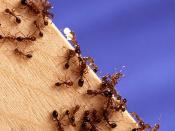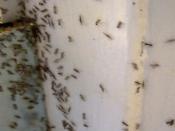Life cycles.
During the reproductive flights of ants, when winged males and female ants mate. After sperm is transferred to the female, the male soon dies. Females land, locates a suitable nesting sites, the female looses her wings and begins laying eggs. The first brood of larvae are fed and cared for by the queen, and develop into sterile female worker ants. Thereafter, her sole role is to lay eggs. Worker ants care for the queen and brood (eggs, larvae and pupae), construct and maintain the nest, defend the colony and forage for food.
Colony Formation of the red imported fire ant. The winged forms, called reproductives, live in the mound until embarking on a mating (nuptial) flight, which usually occurs in the afternoon soon after a rainy period. Mating flights can occur at any time of the year, but they are most common in spring and fall. Males die soon after mating, while the fertilized queen alights to find a suitable nesting site, sheds her wings, and begins digging a chamber in which to start a new colony.
Sometimes, several queens can be found within a single initial nesting site. A newly-mated queen lays a cluster of about a dozen eggs. When they hatch 7 to 10 days later, the larvae are fed by the queen. Later on, a queen supplied with food by worker ants can lay up to 800 eggs per average day. Larvae develop 6 to 10 days and then pupate. Adults emerge in 9 to 15 days. The average colony contains 100,000 to 500,000 workers and up to several hundred winged forms and queens. Queen ants can live 7 years or more, while worker ants generally live about 5 weeks, although they can survive much longer
History
1.1918: black fire ants were accidentally imported for...



Outline
sorry about the way that the outline looks at the end, i guess HTML does not support it...but its info is still correct
1 out of 2 people found this comment useful.